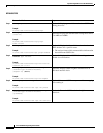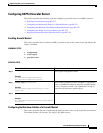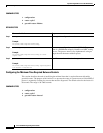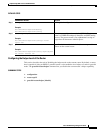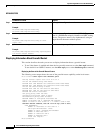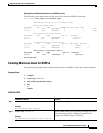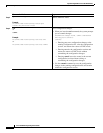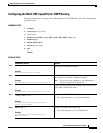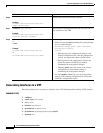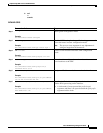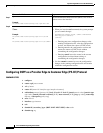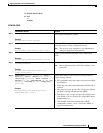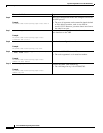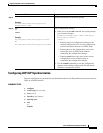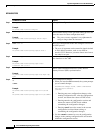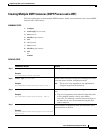
Implementing OSPF on Cisco IOS XR Software
How to Implement OSPF on Cisco IOS XR Software
RC-228
Cisco IOS XR Routing Configuration Guide
Associating Interfaces to a VRF
This task explains how to associate an interface with a VPN Routing and Forwarding (VRF) instance.
SUMMARY STEPS
1. configure
2. router ospf process-name
3. vrf vrf-name
4. interface type instance
5. ipv4 address ip-address mask
6. ipv6 address ipv6-prefix/prefix-length [eui-64]
7. ipv4 mtu mtu
Step 6
disable-dn-bit-check
Example:
RP/0/RP0/CPU0:router(config-ospf-vrf)#
disable-dn-bit-check
Specifies that down bits should be ignored.
Step 7
interface type instance
Example:
RP/0/RP0/CPU0:router(config-ospf-vrf)#
interface interface loopback0
Enters interface configuration mode and associates one or
more interfaces to the VRF.
Step 8
end
or
commit
Example:
RP/0/RP0/CPU0:router(config-if)# end
or
RP/0/RP0/CPU0:router(config-if)# commit
Saves configuration changes.
• When you issue the end command, the system prompts
you to commit changes:
Uncommitted changes found, commit them before
exiting(yes/no/cancel)?
[cancel]:
–
Entering yes saves configuration changes to the
running configuration file, exits the configuration
session, and returns the router to EXEC mode.
–
Entering no exits the configuration session and
returns the router to EXEC mode without
committing the configuration changes.
–
Entering cancel leaves the router in the current
configuration session without exiting or
committing the configuration changes.
• Use the commit command to save the configuration
changes to the running configuration file and remain
within the configuration session.
Command or Action Purpose



